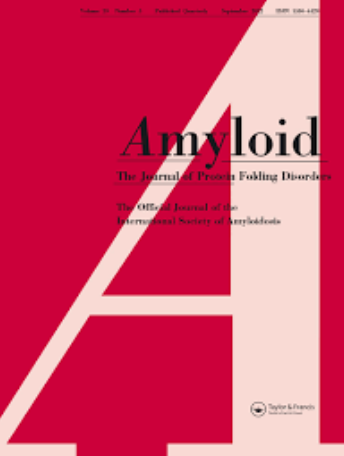Cardiac amyloidosis remains significantly underdiagnosed in patients undergoing TAVR: analysis of National Inpatient Sample.
IF 5.2
2区 医学
Q1 BIOCHEMISTRY & MOLECULAR BIOLOGY
Amyloid-Journal of Protein Folding Disorders
Pub Date : 2023-06-01
DOI:10.1080/13506129.2022.2159369
引用次数: 0
Abstract
Transthyretin cardiomyopathy (ATTR-CM) is among the causes of heart failure with the gravest prognosis. It is estimated that approximately one in four patients with ATTRCM die within 2 years from diagnosis [1]. Recent studies [2,3] have demonstrated that the prevalence of cardiac amyloidosis, mainly wild type ATTR-CM, is as high as 15% in patients with severe aortic stenosis undergoing transcatheter aortic valve replacement (TAVR). In a meta-analysis of all published evidence, we have recently shown that the pooled estimates for the prevalence of cardiac amyloidosis in TAVR is 11.2%, 95% confidence intervals (CI) 9.4–13.3% [1]. Whilst awareness for this condition is increasing, there are still concerns that ATTR-CM remains underdiagnosed and undertreated [4]. In the present study, we sought to explore the prevalence of cardiac amyloidosis cases among patients undergoing TAVR in the United States (U.S). We used data from the U.S. National Inpatient Sample (NIS) from October 2015 to the end of 2019 (Figure 1(A)) [5]. First, we identified hospital admissions with performed TAVR operations using the following ICD-10-PCS Procedure Codes: ‘02RF37H’, ‘02RF38H’, ‘02RF3J’, ‘02RF3KH’, ‘02RF37Z’, ‘02RF38Z’, ‘02RF3JZ’, ‘02RF3KZ’). Then we searched for all hospitalisations with a diagnosis of amyloidosis based on the ICD-10-CM codes (E850, E851, E852, E853, E854, E858, E8582, E8589, E859). In total we identified n1⁄4 45,660 hospital admissions that underwent a TAVR procedure. Extrapolating evidence from our recent meta-analysis on the estimates for cardiac amyloidosis in TAVR, we estimated that the incident amyloidosis cases in this population would be expected to be 5114 cases (95%CI: between 4292 and 6073). However, in the NIS data sample only n1⁄4 47 hospitalised TAVR cases had an ICD-10-CM code relevant to amyloidosis (Figure 1(B)). This accounts for only 1% of the expected patient sample with concomitant severe aortic stenosis undergoing TAVR and potentially latent amyloidosis (n1⁄4 5114). Patients with amyloidosis were less likely to be females, with a non-significant trend for being younger, undergoing non-elective TAVR procedure, having a longer length of in-hospital stay and higher hospitalisation costs (Figure 1(C)) compared to TAVR cases without concomitant amyloidosis; there were no significant differences in the need for permanent pacemaker implantation. Importantly, in-hospital mortality rates were higher in CA amyloidosis patients (4.3% vs. 1.4%, adjusted p1⁄4 0.086, Figure 1(D)). The NIS approximates a 20% stratified sample of discharges from U.S. community hospitals. Extrapolation of the NIS data to all U.S hospitalisations, would yield a statistically significant association between amyloidosis and TAVR in-hospital mortality (unadjusted OR 1⁄4 3.04, 95%CI 1.610–5.73, p< 0.001, and adjusted OR 2.84, 95%CI 1.50–5.38, p< 0.001 after adjustment for age, sex, and nonelective status of the procedure, Figure 1(E)). According to these findings only a minority of the overall population of patients undergoing TAVR with latent amyloidosis are diagnosed. These observations have clinical implications for ATTR-CM diagnosis and treatment, although it remains to be seen whether novel TTR therapeutics can change the clinical outcome of these patients. In addition, given that ATTR-CM patients undergoing TAVR may be at higher risk for in-hospital death, systematic screening of TAVR patients for cardiac amyloidosis could also help in the better risk stratification of TAVR patients. It should be noted that NIS data are descriptive of unique hospital admissions rather than unique patients, and CA0 4心脏淀粉样变性在接受TAVR的患者中仍明显未被诊断:全国住院患者样本分析。
本文章由计算机程序翻译,如有差异,请以英文原文为准。
求助全文
约1分钟内获得全文
求助全文
来源期刊

Amyloid-Journal of Protein Folding Disorders
生物-生化与分子生物学
CiteScore
10.60
自引率
10.90%
发文量
48
审稿时长
6-12 weeks
期刊介绍:
Amyloid: the Journal of Protein Folding Disorders is dedicated to the study of all aspects of the protein groups and associated disorders that are classified as the amyloidoses as well as other disorders associated with abnormal protein folding. The journals major focus points are:
etiology,
pathogenesis,
histopathology,
chemical structure,
nature of fibrillogenesis;
whilst also publishing papers on the basic and chemical genetic aspects of many of these disorders.
Amyloid is recognised as one of the leading publications on amyloid protein classifications and the associated disorders, as well as clinical studies on all aspects of amyloid related neurodegenerative diseases and major clinical studies on inherited amyloidosis, especially those related to transthyretin. The Journal also publishes book reviews, meeting reports, editorials, thesis abstracts, review articles and symposia in the various areas listed above.
 求助内容:
求助内容: 应助结果提醒方式:
应助结果提醒方式:


